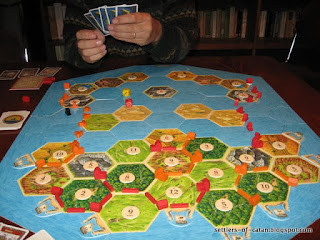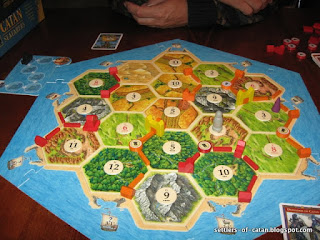After a
slightly frustrating afternoon, despite it being later than usual when we were ready for a game, we decided it would be a good idea to play another Cities and Knights. Just so we didn't forget it all over again. By the time we'd set up it was 9pm, and I'm not an evening person at all. We still couldn't decide how many points was reasonable in the two-player game; maybe 17? 18? more? I suggested that we just play to 10pm and then count points.
Richard played first (with his usual red pieces), and - remembering, this time, how important wheat is in Cities and Knights - opted for a nice spot with two wheat hexes on his first placement. I'd have had that one too, if I'd been playing first. However, there were plenty of other good number combinations, so I chose a couple of them for my two settlements, taking the resource cards for wood, clay and sheep - so I could at least build a street straight away.
Richard then took the two other spots I'd been looking at for his second settlement, and city... and after much deliberation, and some hesitation, I then built my city on the wood harbour, with an 8-sheep and 4-wood hex. Not ideal, but I really wanted some access to an 8 hex, and I also wanted my city to produce the commodities (cloth, coins and paper, necessary for improving cities) and they're only possible from sheep, ore and wood hexes, respectively.

We've decided the first three rounds in this game are free of both the barbarians and the robber. So we don't roll the third die, and if a 7 is rolled, the dice are simply rolled again with no action taken.
We didn't actually get very much done in those first three rounds, however. And once we had the third die in play, it was surprising how often we rolled black (barbarian advance) at the same time as 7:

The same thing happened in
last night's Cities & Knights game. Of course statistics do say that 7 is the most frequently rolled total of the number dice, and 50% of the rolls of the third die should show the barbarian. But still, the combination of the two seemed excessive. I think the robber and the barbarians must have been in communication somehow...
Richard, once again, drew the merchant card once he'd started improving his cities, and enjoyed, for a while, 2:1 trading with wood. I had the wood harbour, but not much wood, so it wasn't much use to me.
I did, however, remember about the metropolis pieces this time, and fairly quickly managed to build one with cloth. It helped that I started out with a city on a 6-sheep hex, and fairly quickly built another one on the 8-sheep hex! I even made it to the final level, where my metropolis was secure from being taken from me.

Ten o'clock came and went. We didn't even think of stopping - we were both too engrossed in the game. I suggested that 10.30 would be a better stopping time.
Richard built his first metropolis, using coins, although he didn't go to the fifth level to secure it. I took the longest street card from him. I had also had the most active knights when fighting off the first barbarian attack. By the time 10.30 came around, or perhaps a little later, I had 17 points: 11 regular buildings, 2 for a metropolis, 2 for the longest street, and a victory point card from defeating the barbarians with the most active knights. I was also controlling the merchant by this stage - having picked up a relevant card - and was in the happy position of being able to trade anything - resource or commodity - at 2:1. I had four resource harbours, plus the merchant on wheat, and had passed the stage of being able to trade 2:1 on all commodity cards.

I'm not sure why we didn't stop at that point, unless perhaps it was that 17 didn't feel like a very useful number. We were just getting into the game properly, and were both interested to see how much further it could go. So we thought we'd keep going for a bit...
Richard rapidly took the longest street card, as I knew he would. I built my last settlement and city, and he built another metropolis. He also won victory points for the next three barbarian attacks, and one development card with a victory point. We'd just about stopped counting points by this stage - we'd decided to play until 11pm - but at this stage, Richard was WAY in the lead. Looking at the board, I can see that he had 14 points in buildings (including the two metropoloi). He also had the longest street, and was controlling the merchant, and had those extra four points on cards.
So he had 21 points in all, while I was trailing behind with 17 (although we weren't counting and hadn't quite realised this. If we had, I think I'd have suggested declaring him as the winner and stopping). I had no way to get the longest street card back... and for a moment, wondered if there was anything at all left that I could do. One can't buy cards in Cities and Knights, after all. I had a handful of cards - I had just rolled a 9, which gave me four clay and two wheat, by this stage, so I traded the clay for another knight level, and made sure they were active. The barbarian, after all, was about to attack.

We decided to play until one more barbarian attack happened, and then - definitely! - stop. Slightly surprisingly, we had quite a few more rounds with coloured gates showing on the third die, meaning that we kept picking up more resources, and more progress cards. I realised that I did have one more thing to do: continue improving my cities, and attempt to take Richard's metropolis pieces from him. A metropolis is awarded to whoever first reaches the fourth level in each kind of building, but if someone else reaches the fifth level first, they get it to keep.
So I traded - I got control of the merchant again, and thus had 2:1 on everything which was very useful. I also took advantage of progress cards that only applied when another player had more victory points than I did! And I managed to get one more metropolis, thus increasing my points by two and decreasing Richard's by the same amount. We'd totally given up counting by this stage, though. I was getting quite tired, and neither of us was keeping track. We were too focused on seeing what else there was to be done.
Finally, the barbarian ship reached Catan. We had way more knights than necessary, and - again we hadn't been counting - discovered that we had exactly the same number of active knights. That meant that neither of us gained a victory point card as defender of Catan; instead we each got to take a progress card.
It was a little after 11pm, and we'd beaten the barbarians one more time. We decided it was definitely time to stop, so we counted up to see who had won.

To our slight surprise, we both had exactly 19 points. What an amicable way of ending a two-hour game. It was interesting that while I was clearly ahead at one point, Richard was easily able to overtake me and get a few points ahead - and then we ended up with the same. It does rather validate our decision that whoever rolls the 7 in Cities and Knights should play the robber, rather than whoever has the lower points (as happens in the regular game for two players).
However, we decided that in future we would play to 18 points when there are just two of us, and probably 15 with more than two players. . That's fairly easily achievable, but beyond that the game does feel a bit long-winded.
We're still not at all sure that we're confident enough to teach this to friends who don't know it, though! Clearly we need to play several more rounds so it begins to feel as familiar as the regular Settlers game.






















































